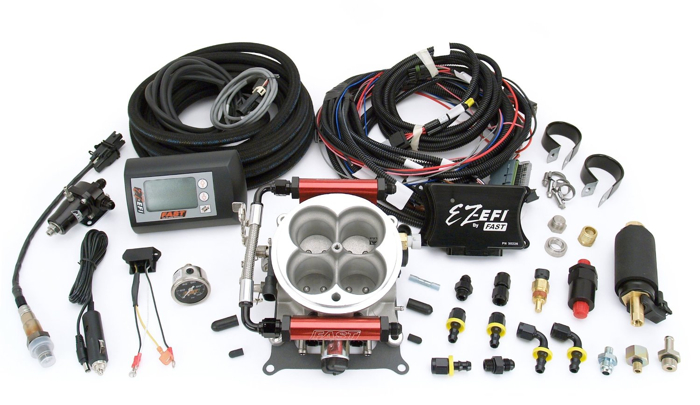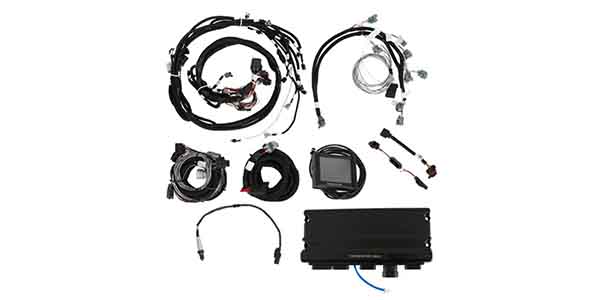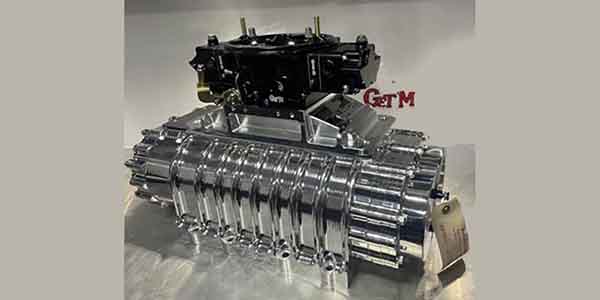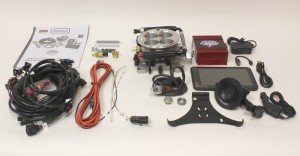
Carburetors have long served the performance aftermarket and racing industry well. Although they disappeared from new vehicles back in the late 1980s to meet emission requirements, it was only a couple of years ago that NASCAR finally abandoned carburetors in favor of fuel injection.
Carburetors are mechanical metering devices that use atmospheric air pressure and intake vacuum to deliver fuel to the engine. Intake vacuum siphons fuel from the fuel bowl through the main metering circuit and idle circuit so it can mix with air as the air/fuel mixture enters the intake manifold. Cold starting requires a fairly rich air/fuel mixture, so a manual or automatic choke is needed to restrict airflow into the carburetor and to increase the throttle opening for a faster cold idle speed while the engine warms up. Chokes require adjusting, and can be troublesome. Race carburetors have no chokes because they get in the way which can make starting difficult in cooler weather.
Carburetors also have adjustment screws for the idle mixture and idle speed. The idle mixture affects idle speed, so the two have to be adjusted more or less simultaneously so the idle will not be too fast or too slow.
Opening the carburetor throttle to accelerate requires an accelerator pump circuit and discharge nozzles so the engine doesn’t bog when it ingests a big gulp of air. Setting up the accelerator pump can also be tricky because too much fuel is just as bad as too little fuel. And if somebody pumps the throttle linkage a little too much when cranking the engine, they can flood the engine and wet foul the spark plugs.
Carburetors also have a power valve circuit to add extra fuel when the engine is lugging under load and intake vacuum drops.
Carburetors also require constant adjustments. As soon as the air temperature or atmospheric pressure changes, it’s out of tune. The float level setting inside the fuel bowl affects the air/fuel mixture, which is determined mostly by the size of the main metering jets or needles. Adjusting the air/fuel mixture requires manually changing the jets to richen or lean the fuel mixture. On a hot summer day, warm air is less dense so smaller main jets are needed to maintain the same air/fuel ratio. Conversely, on a colder day air is more dense so larger jets are needed to prevent the air/fuel mixture from leaning out.
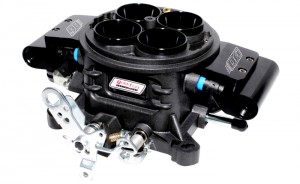
While the market is awash with bolt-on EFI systems, QFI is different: It combines the superior fuel atomization aspects of a carburetor with the precise fuel control of EFI.
This constant back and forth fiddling has long been a ritual of race day carburetor tuning. But with fuel injection, you don’t need a screwdriver or wrenches to change jets, accelerator pumps and power valves because Electronic Fuel Injection (EFI) is self-tuning.
How EFI Works
With fuel injection, the fuel mixture is monitored by a wideband oxygen sensor mounted in the exhaust. Throttle position, air temperature and manifold absolute pressure (MAP) are also monitored by separate sensors. Feedback from these sensors allow the EFI control unit to constantly fine tune the fuel mixture to changing operating conditions.
EFI is less dependent on intake vacuum for fuel delivery because fuel is sprayed into the engine through injectors. A fuel pressure regulator maintains steady line pressure to the injectors, while the EFI control unit determines the duration (on time) of each injector when fuel is sprayed into the engine. Increasing injector duration adds more fuel while decreasing injector duration leans the air/fuel mixture.
With throttle body EFI systems, fuel is sprayed through the throttle body into the intake manifold like a carburetor. With multi-port EFI, each cylinder has its own separate injector and fuel is sprayed directly into the intake ports in the cylinder head. If the multi-port EFI system has “sequential” injection, each injector is triggered individually rather than gang fired, which allows for faster, real time air/fuel adjustments.
Many late model engines with Gasoline Direct Injection (GDI) take it a step further and spray fuel directly into the combustion chamber under extremely high pressure, similar to a diesel. Currently, there are no aftermarket GDI conversion kits available. Such a kit would require different cylinder heads, different pistons (because GDI pistons usually have depressions, pockets and/or ramps to direct airflow within the cylinder), and a high pressure mechanical fuel pump. However, there are numerous aftermarket throttle body and multi-port EFI conversion kits that allow almost any carbureted engine to be converted to EFI.
EFI Advantages
EFI offers a number of important advantages over a mechanical carburetor:
• Because fuel is sprayed under pressure into the engine, there is much better fuel atomization. A more homogeneous air/fuel mixture improves cold starting, idle smoothness, throttle response, fuel economy and emissions.
• Throttle body EFI systems can be easily installed on almost any engine with a square bore 4150 or 4500 style intake manifold, including dual quad carburetor setups on higher horsepower engines. It’s pretty much a bolt-on installation that uses the same throttle linkage and air cleaner as the original carburetor. It doesn’t alter the basic look of the engine or intake plumbing.
• EFI provides consistent all-year drivability for street driven vehicles. It’s an ideal upgrade for a vintage muscle car, sports car, classic car, street rod, resto rod or race car (if rules allow it). Many of today’s resto rods are fueled by some type of EFI system (OEM or aftermarket). With EFI, you don’t have to wait five minutes for the engine to warm up before you can drive away without the engine bogging or backfiring. An EFI conversion allows the engine to fire immediately with the first crank, to idle smoothly whether the engine is hot or cold, and to accelerate without any embarrassing pops, sputters or bogs.
• On many applications, EFI can actually add horsepower (although some would argue that a big carburetor always makes more power). An engine can usually handle a throttle body with larger bores (and thus more CFM airflow) with EFI. Some throttle body EFI systems are rated at 1100 CFM, which is considerably more than your typical 650 or 800 CFM carburetor that’s often used on a small block or big block motor. A carburetor that’s too big for a given engine will often have poor throttle response and torque at low to mid-range RPM, but work well at high RPM. With EFI, a larger throttle body works well at all engine speeds.
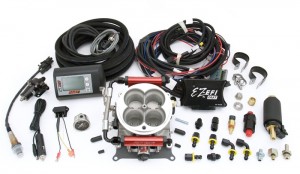
A multi-port EFI system with a front-mounted throttle can sometimes provide better airflow into the engine than a single plane intake manifold with a carburetor. Some EFI suppliers claim the change is good for 20 more horsepower over a carburetor.
• Multi-port EFI provides better cylinder-to-cylinder fuel distribution than a carburetor because only air flows through the intake manifold. With a carburetor, droplets of fuel can separate and puddle when the air/fuel mixture turns corners. The end cylinders also tend to run leaner than the center cylinders in V8 engines with a carburetor. Some intake manifold designs do a better job than others of equalizing airflow and fuel distribution, but with multi-port EFI it is less of an issue.
• Most bolt-on throttle body EFI kits can handle engines from 450 to 650 horsepower depending on the flow rate of the injectors and fuel pump that are used. With dual EFI throttle bodies, up to 1,200 horsepower is possible depending on the application.
• EFI can also be used with turbochargers, superchargers and/or nitrous oxide. Programming allows the EFI control unit to adjust the fuel mixture and timing under boost pressure or when the engine receives a shot of nitrous.
• Most throttle body EFI systems as well as some of the multi-port EFI systems are self-tuning and do not require a laptop or advanced computer skills to tune and adjust. For serious racing, the more advanced professional high horsepower port EFI systems do require a laptop and advanced tuning skills to dial in. The fuel mixture and ignition timing maps can be worked out on a dyno or with the engine in the vehicle – the latter typically results in a better tune because it takes into account the effects the transmission, drivetrain and exhaust system have on engine performance. The more sophisticated the control unit, the more data points it allows in the fuel and ignition maps.
Most EFI conversion kits are “speed-density” systems that use engine speed, throttle position, air temperature and intake manifold pressure to estimate airflow into the engine. Some original equipment EFI systems are also speed-density systems (Chrysler and older GM Tuned Port Injection), but most are “mass airflow” systems that use an expensive MAF sensor mounted ahead of the throttle body to read airflow into the engine. MAF systems are more accurate but are also more sensitive to vacuum leaks and dirt contamination.
Basic EFI Setup Procedure
The initial setup of an aftermarket self-tuning EFI conversion system is fairly simple thanks to the plug-in handheld device that is provided with the kit. The device allows the EFI controller to be programmed with the basic setup information it requires to operate the system. This includes inputs such as engine displacement, number of cylinders, cam duration, fuel pump type (pulse width modulated with no regulator, pulse width modulated with regulator or non-pulse width modulated with regulator), desired idle RPM and rev limit. Some EFI conversion kits also have the ability to control ignition timing. If used this requires some additional inputs.
Once the engine is fired up with its initial settings, the EFI controller starts to adjust the air/fuel mixture using a closed loop feedback signal from the oxygen sensor. The O2 sensor signal is used for short term and long-term fuel trim adjustments at various engine speeds, loads and throttle positions. This generates a map of what adjustments are needed to maintain the proper air/fuel ratio during various operating conditions, ranging from idle to part throttle to cruise to wide open throttle.
It typically takes a couple of days of driving at various speeds before everything is really dialed in. From that point forward, adaptive learning will continue to fine tune the system as operating conditions change. Additional tweaks can be made on some systems with a laptop if further changes are desired.
However…
As Engine Builder contributor Bob McDonald recently reported (“Deep Breathing,” February 2015), as great as EFI is, it’s not always the perfect choice. There are some disadvantages to consider compared to a carburetor:
• For old-school guys, computer controls, oxygen sensors and laptop tuning can be intimidating. If they are used to fiddling with a carburetor and have good carburetor tuning skills, they will usually stick with what they know rather than venture into the unfamiliar territory of EFI. These types of customers may be converted to EFI if they see the advantages EFI provides on somebody else’s engine. The self-tuning EFI kits also reduce the intimidation factor of converting a carburetor to EFI.
• EFI requires installing an oxygen sensor in the exhaust manifold. Most kits include only one wideband O2 sensor. The sensor can be installed in either exhaust manifold or header collector on a V8 or V6 engine. This provides somewhat less than an ideal feedback because the sensor is only reading one side of the engine. Even so, the single O2 sensor setup simplifies installation and keeps the cost of the system down. OEM EFI systems always use separate oxygen sensors for each cylinder bank because it provides more precise fuel control.
Installing the oxygen sensor requires drilling a hole in the exhaust manifold or header collector and welding or clamping a bung on the hole so the sensor can be screwed into the fitting. The sensor should be positioned with an upward slant (10 degrees or more) so exhaust moisture will drain back into the pipe when the engine is shut off.
The basic idea is to position the O2 sensor so it reads the exhaust from all of the cylinders on that side of the engine. It won’t work with individual “zoomie” style headers because the sensor would only read one cylinder.
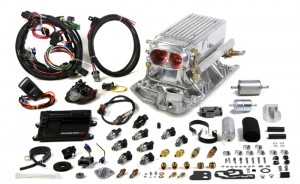
Another requirement is that there must be some exhaust tubing beyond the exhaust manifold or header collector to prevent reversionary airflow between cylinder pulses from misleading the sensor. If air flows backwards into the collector where the O2 sensor is located, it can produce erratic or inaccurate readings that will upset the air/fuel mixture. Also, any air leaks (even small ones) at the exhaust manifold or header flange gasket or in the manifold tubing can mislead the sensor and upset the air/fuel mixture.
• EFI requires installing an electric fuel pump, a simple, in-line, high pressure electric pump or an in-tank pump. Most EFI systems require a pump that can deliver 45 to 70 PSI. A low-pressure electric pump that is designed for a carburetor won’t work.
In-tank pumps run cooler and quieter than in-line pumps, and are better protected from road hazards. But an in-tank pump is more of a pain to install in a vehicle that does not have an in-tank pump, and it makes pump replacement and service more difficult if the pump needs to be replaced at a later date. Return-less EFI systems have the fuel pressure regulator in the tank as part of the pump module assembly. This eliminates the need to install a separate return line to route fuel back to the tank from an external pressure regulator. However, if a customer is installing a return style EFI system, a return line is required.
• EFI costs more than a carburetor. You can buy a carburetor for $400 to $1,500 depending on the size, style and modifications that have been made to the carburetor. A single throttle body EFI conversion kit, by comparison, will set you back $2,000 to $2,500, and a port EFI kit can cost upwards of $3,000 or more depending on the capabilities of the kit and what type of injectors, fuel pump and electronic controls are included.
• All EFI conversion kits require an ignition input signal to monitor engine RPM and to trigger injector pulses whether the EFI system controls ignition timing or not. Most kits will work with a GM HEI, Ford TFI or other electronic distributor. If an engine has an mechanical contact point distributor, it will have to be converted to an electronic distributor. Some professional multi-port EFI systems use a crank position sensor for a trigger signal.
Other Considerations
Since carburetors can now be easily replaced with fuel injection, the opposite is also true: newer Chevy LS and Ford 4.6L modular V8s can be retrofitted to a carburetor for use in older vehicles. If a customer doesn’t want EFI or computerized engine controls in his vintage muscle car, street rod or other vehicle, but he desires a more modern engine (like a Chevy LS or Ford modular V8), there are aftermarket conversion kits that replace the stock EFI intake manifold, throttle body, injectors, wiring harness and sensors with a carburetor and manifold. This type of conversion also requires adding some type of self-contained electronic ignition to replace the OEM ignition system.
This type of setup isn’t for everyone, but for those who want something “different” it offers yet another powertrain option for repowering a street rod, resto rod, vintage muscle car or classic car. n
Special thanks to the manufacturers and suppliers that provided information and assistance to this article. For more information visit their Web sites: Edelbrock – www.edelbrock.com; FAST – www.fuelairspark.com; Holley Performance Products – www.holley.com; MSD Performance – www.msdperformance.com; Professional Products – www.professional-products.com; and Quick Fuel Technology – www.quickfueltechnology.com.

